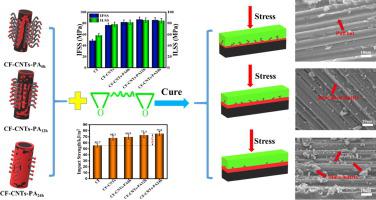Journal of Colloid and Interface Science ( IF 9.4 ) Pub Date : 2020-09-15 , DOI: 10.1016/j.jcis.2020.09.005 Peifeng Feng , Guojun Song , Xiaoru Li , Hui Xu , Longyu Xu , Diandong Lv , Xu Zhu , Yudong Huang , Lichun Ma

|
In order to comprehend the influence of different “rigid-flexible” structures on the interface strength of carbon fiber(CF)/epoxy composites, CNTs was firstly chemically grafted on CFs surface, and then polyamide (PA) was grafted onto CF-CNTs surface through varying anionic polymerization time of caprolactam [CF-CNTs-PAn (n = 6 h, 12 h, 24 h)]. X-ray photoelectron spectroscopy (XPS) and Raman spectroscopy indicated the successful establishment of CNTs and PA. TGA demonstrated the different grafting amounts of CF-CNTs-PAn (n = 6 h, 12 h and 24 h). SEM images revealed a compactness and uniform coverage of the CNTs/PA, with increasing polymerization time, the CF and CNTs surface was covered by a thick layer of PA. The surface energy increased and then decreased. The optimal interfacial shear strength (IFSS) and interlaminar shear strength (ILSS) of the CF/epoxy composites with a polymerization time of 12 h (CF-CNTs-PA12h) was 86.7 and 85.4 MPa, which was 77.6% and 45.7% higher than that of untreated CF/epoxy composite. As the polymerization time grew, the impact toughness and tensile strength of CF/epoxy composites enhanced and conductivity of CF/epoxy composite reduced. In addition, the mechanisms of reinforcement and toughening were also illuminated. This work would provide a certain theoretical basis for the preparation and applications of high-performance CF composites with different structures.
中文翻译:

碳纤维表面不同的“刚柔”结构对碳纤维/环氧树脂复合材料界面微观结构和力学性能的影响
为了理解不同的“刚柔”结构对碳纤维/环氧树脂复合材料界面强度的影响,首先将碳纳米管化学接枝到碳纤维表面,然后将聚酰胺(PA)接枝到碳纳米管表面。通过改变己内酰胺[ CF-CNTs-PA n(n = 6 h,12 h,24 h)]的阴离子聚合时间。X射线光电子能谱(XPS)和拉曼光谱表明成功建立了CNT和PA。TGA表明CF-CNTs-PA n(n = 6 h,12 h和24 h)。SEM图像显示,随着聚合时间的增加,CNTs / PA的致密性和均匀覆盖度增加,CF和CNTs表面被厚厚的PA覆盖。表面能先升高后降低。聚合时间为12 h(CF-CNTs-PA 12h)的CF /环氧树脂复合材料的最佳界面剪切强度(IFSS)和层间剪切强度(ILSS))分别为86.7和85.4 MPa,分别比未处理的CF /环氧树脂复合材料高77.6%和45.7%。随着聚合时间的增加,CF /环氧树脂复合材料的冲击韧性和拉伸强度提高,CF /环氧树脂复合材料的电导率降低。此外,还阐明了增强和增韧的机理。这项工作将为不同结构的高性能CF复合材料的制备和应用提供一定的理论基础。











































 京公网安备 11010802027423号
京公网安备 11010802027423号